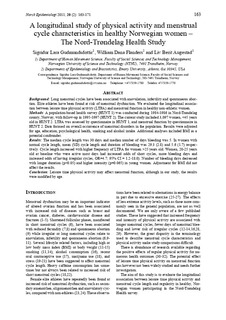| dc.contributor.author | Gudmundsdottir, Sigridur Lara | |
| dc.contributor.author | Flanders, William Dana | |
| dc.contributor.author | Augestad, Liv Berit | |
| dc.date.accessioned | 2019-08-29T11:22:11Z | |
| dc.date.available | 2019-08-29T11:22:11Z | |
| dc.date.created | 2011-06-20T12:10:52Z | |
| dc.date.issued | 2011 | |
| dc.identifier.citation | Norsk Epidemiologi. 2011, 20 (2), 163-171. | nb_NO |
| dc.identifier.issn | 0803-2491 | |
| dc.identifier.uri | http://hdl.handle.net/11250/2611600 | |
| dc.description.abstract | Background: Long menstrual cycles have been associated with anovulation, infertility and spontaneous abortion. Elite athletes have been found at risk of menstrual dysfunction. We evaluated the longitudinal association between leisure time physical activity (LTPA) and menstrual function in healthy non-athletic women.
Methods: A population-based health survey (HUNT 1) was conducted during 1984-1986 in Nord-Trøndelag county, Norway, with follow-up in 1995-1997 (HUNT 2). The current study included 3,097 women, <45 years old in HUNT 2. LTPA was assessed by questionnaire in HUNT 1, and menstrual function by questionnaire in HUNT 2. Data focused on overall occurrence of menstrual disorders in the population. Results were adjusted
for age, education, psychological health, smoking and alcohol intake. Additional analyses included BMI as a potential confounder.
Results: The median cycle length was 30 days and median number of days bleeding was 5. In women with normal cycle length, mean (SD) cycle length and duration of bleeding was 29.3 (2.8) and 5.6 (1.7) respectively. Cycle length increased with higher frequency of LTPA for women >25 years old. Women, 20-25 years old at baseline who were active most days had increased odds of short cycles, more bleeding days and increased odds of having irregular cycles, OR=4.7; 95% CI = 1.2-18.0). Number of bleeding days decreased with longer duration (p<0.05) and higher intensity (p=0.065) in young women. Adjustment for BMI did not affect the results.
Conclusion: Leisure time physical activity may affect menstrual function, although in our study, the results were modified by age. | nb_NO |
| dc.language.iso | eng | nb_NO |
| dc.publisher | Norwegian Epidemiological Association (NOFE) | nb_NO |
| dc.rights | Navngivelse 4.0 Internasjonal | * |
| dc.rights.uri | http://creativecommons.org/licenses/by/4.0/deed.no | * |
| dc.title | A longitudinal study of physical activity and menstrual cycle characteristics in healthy Norwegian women – The Nord-Trøndelag Health Study | nb_NO |
| dc.type | Journal article | nb_NO |
| dc.type | Peer reviewed | nb_NO |
| dc.description.version | publishedVersion | nb_NO |
| dc.source.pagenumber | 163-171 | nb_NO |
| dc.source.volume | 20 | nb_NO |
| dc.source.journal | Norsk Epidemiologi | nb_NO |
| dc.source.issue | 2 | nb_NO |
| dc.identifier.cristin | 826198 | |
| dc.description.localcode | This work is licensed under a Creative Commons Attribution 4.0 International License. | nb_NO |
| cristin.unitcode | 194,65,30,0 | |
| cristin.unitname | Institutt for nevromedisin og bevegelsesvitenskap | |
| cristin.ispublished | true | |
| cristin.fulltext | original | |
| cristin.qualitycode | 1 | |

